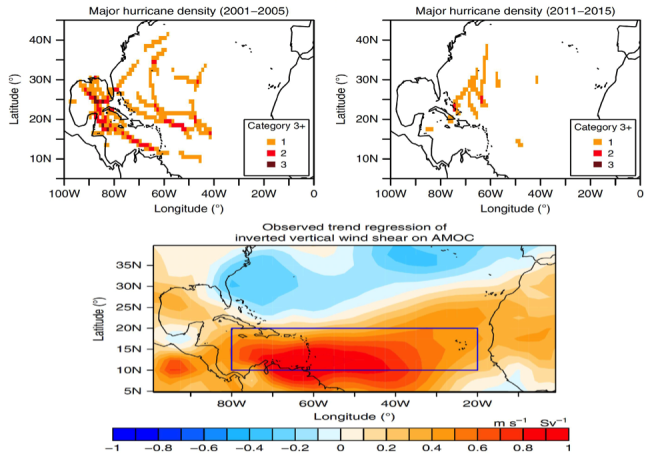Atlantic overturning circulation and the recent decline of Atlantic major hurricane frequency
The observed Atlantic major hurricane frequency has exhibited pronounced multidecadal variability since the 1940s. However, the cause of this variability is debated. Previous studies have found it to be well correlated with the low-frequency variations in the North Atlantic sea surface temperature associated with the Atlantic multidecadal variability (AMV). Additionally, changes in anthropogenic sulfate aerosol forcing have been proposed as the dominant cause of the AMV and the historical multidecadal variations in Atlantic tropical storm frequency, based on some model simulations including aerosol indirect effects. In these simulations, a decrease in anthropogenic sulfate aerosols leads to an increase in tropical storms and vice versa. On the other hand, there are large uncertainties in simulated aerosol indirect effects and substantial mean state biases in the North Atlantic.

In a recent paper published in Nature Communications, using both observations and a coupled Earth system model (GFDL-ESM2G) with a more realistic simulation of the Atlantic Meridional Overturning Circulation (AMOC) structure, and thus reduced mean state biases in the North Atlantic, the authors show that the decline of the Atlantic major hurricane frequency during 2005–2015 is associated with a weakening of the AMOC directly observed from the RAPID program. The observed North Atlantic sulfate aerosol optical depth has not increased (but shows a modest decline) over this period, suggesting the decline of the Atlantic major hurricane frequency during 2005–2015 is not likely due to recent changes in anthropogenic sulfate aerosols. The observational and modeling results of the teleconnections linked to AMOC changes (including the dynamical response of vertical wind shear over the main development region of Atlantic hurricanes) suggest an important role of the AMOC in the AMV and the multidecadal variability of the Atlantic major hurricane frequency. These results also highlight the influence of a weakening of the AMOC on the recent decline of Atlantic major hurricane frequency during 2005-2015. Hence, monitoring and predicting AMOC changes will be crucial for developing a robust predictive understanding of future Atlantic hurricane risk.
The role of Atlantic overturning circulation in the recent decline of Atlantic major hurricane frequency (Nature Communications)
1Princeton University
2NOAA Geophysical Fluid Dynamics Laboratory
Topics
- Modeling
- Atlantic Ocean
- Air-Sea
- AMOC
- Hurricane
- Extreme Events
